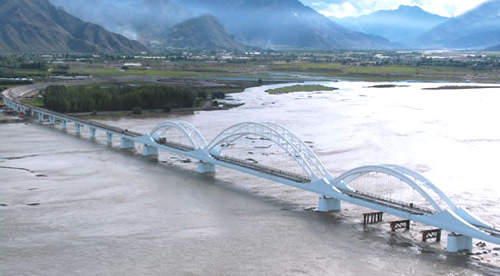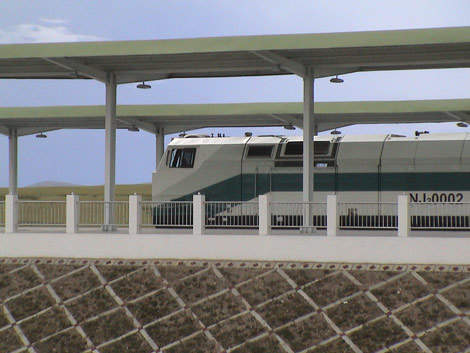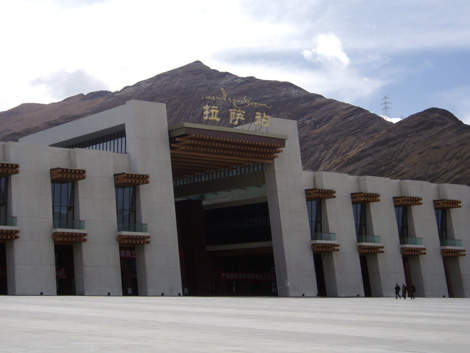Built quite literally on the roof of the world – at an average elevation around 4,500m above sea level – the Qinghai-Tibet railway represents the culmination of the long-held Chinese dream of connecting China to Tibet.
Running for over 1,956km from Xining, capital of China’s Qinghai province to Lhasa, through some of the planet’s harshest natural conditions, it is an impressive catalogue of world records. With its highest point at an altitude of 5,072m – 200m or more above the Peruvian railway in the Andes – Qinghai-Tibet easily takes the title as the world’s highest track and Tanggula Station, a mere 4m lower, the highest railway station.
It is also the longest plateau railway in the world. Some 550m of its tracks are on frozen earth, passing through both the world’s most elevated tunnel – Fenghuoshan Tunnel (4,905m) – and the longest plateau tunnel – Kunlun Mountain (1,686m) – to be built on frozen earth.
Inevitably, constructing the line on permafrost and at an altitude where the air contains 35–40% less oxygen than at sea level presented some unique technical difficulties – with the route’s passage through the Kunlun earthquake zone adding its own additional challenges. The original section, covering the 815km from Xining to Golmud, opened in 1984, but it was not until 2001 that work began on the final 1,142 km to Lhasa. The line was completed in October 2005 at a cost of over $3.5bn.
The project
China had harboured the goal of linking Qinghai province to the Tibetan Autonomous Region by rail since the early 1950s. At the time, although engineers and surveyors were sent to investigate the potential, both finance and the then-available technology proved insufficient for the task. By the 80s, building the first part of the scheme had become possible and China’s rapid post-millennial economic growth allowed the second – and far more challenging – part of the project to get underway.
The project forms an element of China’s Western Development strategy; an initiative intended to aid the country’s western provinces, which are much less developed than those in the east. Hailed as one of modern China’s greatest feats by the government, building the railway posed a number of engineering challenges and some innovative approaches have been used to overcome them.
Around half of the Golmud to Lhasa section was laid on barely permanent permafrost with winter temperatures that plummet to -35ºC, while the summer’s 30+º sees the upper layers thawing to mud. The engineers approached this problem by constructing elevated tracks and causeways over some of the most difficult terrain, while in other areas, pipes have been installed to circulate liquid nitrogen below the rail bed to keep the ground frozen.
Providing a steady and reliable signalling and communication system over so long a distance in such a harsh environment presented its own problems, not least in terms of guaranteeing the continuity of electrical supply. To help meet this need, an assistant solar power supply system – comprising nine solar power supply stations, with a gross capacity of 122.4kW – was installed, with a further seven supply stations along the length of the railway. The highest of these, at an altitude of 5,100m, is claimed to be another world first.
The thin air at this altitude made construction difficult, although special oxygen facilities were provided for the workforce, and poses a challenge for passengers too. Before embarking, a passenger health registration card must be filled in – requiring travellers to read and sign a high-altitude travel disclaimer. Although externally the carriages have a traditional appearance, beneath the exterior, they are purpose built for the rigours of their route, boasting UV-filtering windows and a supplementary oxygen supply for each passenger.
Despite these precautions, in August 2006 the first death was reported – a 75-year-old man who had been suffering from heart problems but insisted on travelling on to Xining. Three months later, a woman died while giving birth alone in the train’s lavatory. However, according to the Chinese Ministry of Railways, there were no fatalities during construction as a result of altitude-related causes, although 40 workers were killed in other accidents.
Social implications
The limited industrial capacity of Tibet formed one of the major drivers on the project. With the Tibetan economy highly dependent on imports from the more developed and industrialised regions of China, the transport of goods in and out of the region is an important issue. Before the railway’s construction, the principal route was the Qingzang Highway, built in the 1950s, which connects Tibet to the neighbouring Qinghai province.
However, the distances and terrain have proven to be serious limitations on the road’s effectiveness, with less than a million tonnes of goods being transported yearly. The new railway brings a significant reduction in transport costs and is projected to facilitate increased movements of goods – 2.8 million tonnes are predicted by 2010, of which three quarters will be carried by train.
It is also expected to increase tourism to the area. The line has already stimulated further air links to the once isolated region, with Hainan Airline launching Xi’an-Lhasa flights in May 2007, followed by China Eastern Air in June.
China’s state media reported that by the end of July 2007, Tibet had seen over 1.7 million arrivals – only slightly fewer than in the whole of 2005 – leading to a revision of the whole year forecast, adding half a million to increase the total now expected to 3.5 million.
However, the project has also attracted criticism, being seen by many as an attempt by Beijing to strengthen its political control of Tibet, facilitate Chinese immigration into the region and accelerate the dilution of Tibetan culture. Some have also voiced concerns that the railway will allow greater military presence in the Tibet Autonomous Region as well as facilitating Beijing’s exploitation of Tibet’s natural resources.
Rolling stock
The railway uses GE Transportation NJ2 and Qishuyang series DF8CJ 9000 locomotives and 361 Bombardier Transportation high-altitude passenger carriages, of which 308 are standard and 53 are special tourist cars.
The future
A series of extensions are planned to extend the rail network both within and outside Tibet. In 2007 work began on the new line linking Lhasa and Shigatse, 280km to the south west. This will be the first branch line for the Qinghai-Tibet railway and is scheduled to be operational in 2010. Further extensions are also to be built to link Shigatse to Zhangmu, Nyingchi to Dali and Shigatse with Yadong.
In 2008, China announced a plan to extend railway line to neighbouring Nepal. Officials also revealed plans to lay Qinghai-Tibet Railway’s first branch line connecting Lhasa and Xigaze, Tibet’s second-largest city. According to Chinese media sources, this branch line will then be extended to the China-Nepal border, about 400km away from the city.















